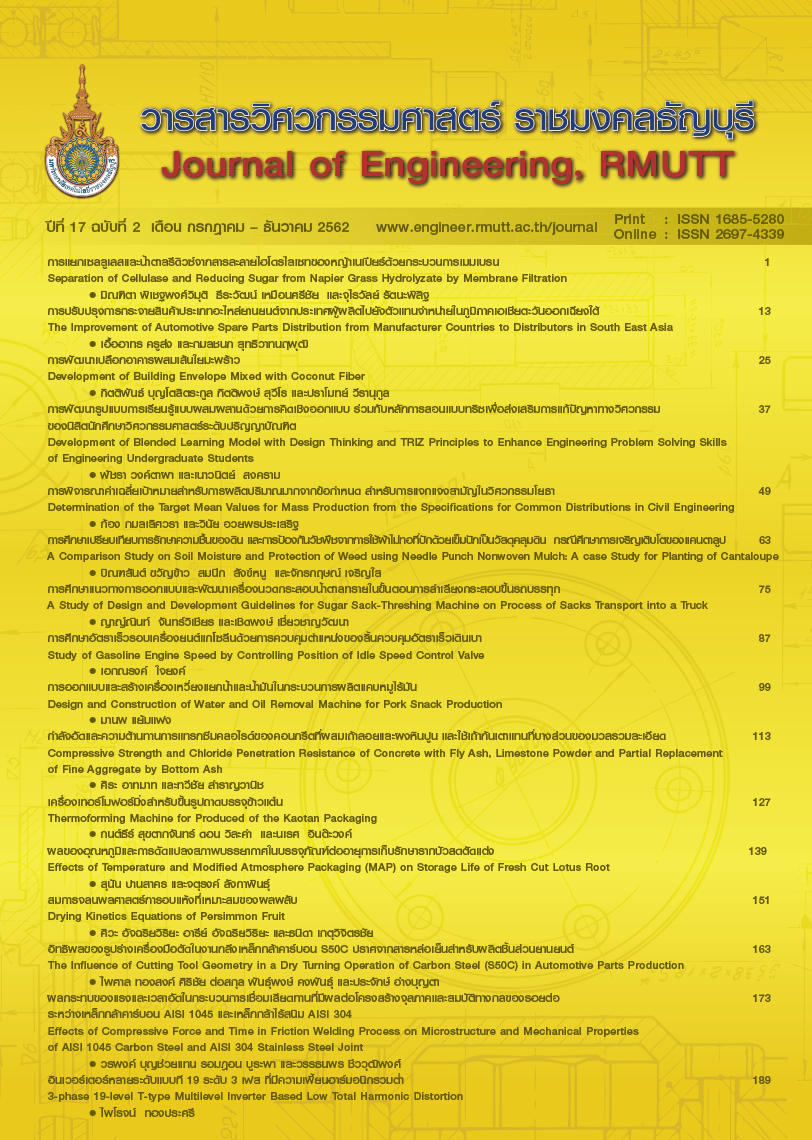การศึกษาเปรียบเทียบการรักษาความชื้นของดิน และการป้องกันวัชพืชจากการใช้ผ้าไม่ทอที่ปักด้วยเข็มปักเป็นวัสดุคลุมดิน กรณีศึกษาการเจริญเติบโตของแคนตาลูป
Main Article Content
บทคัดย่อ
วัสดุคลุมดิน เป็นวัสดุที่มีวัตถุประสงค์หลักเพื่อใช้ในการรักษาความชื้นในดิน ในขณะเดียวกันยังสามารถลดปริมาณวัชพืชในแปลงพืช ปัจจุบันวัสดุที่นำมาใช้เป็นวัสดุคลุมดินมีหลากหลายชนิดทั้งที่ได้จากวัสดุธรรมชาติ วัสดุสังเคราะห์ และวัสดุคลุมดินที่เป็นสิ่งทอทางเกษตรเช่น วัสดุคลุมดินจากผ้าไม่ทอ เป็นต้น เมื่อนำเส้นใยพอลิเอสเทอร์ มาทำการพัฒนาเป็นวัสดุคลุมดิน โดยทดลองผลิตเป็นผ้าไม่ทอด้วยเทคนิคปักด้วยเข้มปัก ทั้งหมด 4 ตัวอย่าง ผ้าไม่ทอตัวอย่าง A มวล 47 g/m2 หนา 0.28 mm, ผ้าไม่ทอตัวอย่าง B มวล 105 g/m2 หนา 0.90 mm, ผ้าไม่ทอตัวอย่าง C มวล 155 g/m2 หนา 1.27 mm และผ้าไม่ทอตัวอย่าง D มวล 210 g/m2 หนา 2.62 mm นำผ้าที่ได้ศึกษาสมบัติด้านความแข็งแรงพบว่า ผ้าไม่ทอตัวอย่าง C แข็งแรงมากที่สุด ผ้าไม่ทอตัวอย่าง A และ D ไม่สามารถทดสอบได้เนื่องจากผ้าบาง และหนาเกินไป นอกจากนั้นผ้าไม่ทอทั้ง 4 ตัวอย่าง ยังถูกนำไปศึกษาเป็นวัสดุคลุมดินบนแปลงต้นแคนตาลูป และเปรียบเทียบกับ 3 แปลงได้แก่ แปลงที่ไม่มีวัสดุคลุมดิน, แปลงที่ใช้พลาสติก และแปลงที่ใช้ฟางข้าวเป็นวัสดุคลุมดิน พบว่าแปลงของผ้าไม่ทอตัวอย่าง D สามารถรักษาความชื้นในดินดี จำนวนวัชพืชที่พบมีน้อยลำต้นแคนตาลูปเจริญเติบโตได้ดี ขนาดของผล และใบเมื่อเทียบกับแปลงอื่น แปลงที่ใช้ผ้าไม่ทอตัวอย่าง D ยังได้ผลผลิตดี
Article Details
บทความ ข้อมูล เนื้อหา รูปภาพ ฯลฯ ที่ได้รับการตีพิมพ์ในวารสารแนวหน้าวิจัยนวัตกรรมทางวิศวกรรม ถือเป็นลิขสิทธิ์ของวารสารฯ เท่านั้น ไม่อนุญาติให้บุคคลหรือหน่วยงานใดคัดลอกเนื้อหาทั้งหมดหรือส่วนหนึ่งส่วนใดไปเผยแพร่เพื่อกระทำการใด ๆ ที่ไม่ถูกต้องตามหลักจริยธรรม
เอกสารอ้างอิง
Deng L, Wang K, Li J, Zhao G, Shangguan Z. Effect of soil moisture and atmospheric humidity on both plant productivity and diversity of native grasslands across the Loess Plateau, China. Ecological Engineering. 2016;(94):525-31.
Paul, J. Kramer. Soil Moisture in Relation to Plant Growth. The Botanical Review. 1944(9):525-559.
Kyriacou MC, Leskovar DI, Colla G, Rouphael Y. Watermelon and melon fruit quality: The genotypic and agro-environmental factors implicated. Scientia Horticulturae. 2018;(234):393-408.
Kyrikou I, Briassoulis D. Biodegradation of Agricultural Plastic Films: A Critical Review. Journal of Polymers and the Environment. 2007;15(3):227-.
Heisler-White JL, Knapp AK, Kelly EF. Increasing precipitation event size increases aboveground net primary productivity in a semi-arid grassland. Oecologia. 2008;158(1):129-40.
C. PDP, Jin Y, E. SO, P. AJ. Directional climate change and potential reversal of desertification in arid and semiarid ecosystems. Global Change Biology. 2012;18(1):151-63.
Rukkla [Internet]. ; 2017. The manual of melon plant; 2018 [22 Apr 2018]; [about 1 p.] from: https://www.rukkla.com/content/1 0739/คู่มือการปลูกแคนตาลูป. (in Thai)
Sanook [Internet].; 2015. New generation and Super rich Melon;2018 [22 Apr 2018]; [about 1 p.]; [about 1 p.] from:http://money.sanook.com/260137. (In Thai).
Chalker-Scott L. Impact of Mulches on Landscape Plants and the Environment — A Review. Journal of Environmental Horticulture. 2007;25(4):239-49.
Xiangwu, Z. Fundamentals of Fiber Science. 1st ed. Pensylvania: Destech Publication, Inc; 2014
Weerasak Udomkeasy. Fiber since. 1st ed. Bangkok: Chulalongkorn University Printing House;1999. (In Thai)
Russell SJ, Smith PA. 6 - Technical fabric structures – 3. Nonwoven fabrics A2 - Horrocks, A. Richard. In: Anand SC, editor. Handbook of Technical Textiles (Second Edition): Woodhead Publishing; 2016. p. 163-88.
Zribi W, Aragüés R, Medina E, Faci JM. Efficiency of inorganic and organic mulching materials for soil evaporation control. Soil and Tillage Research. 2015;148:40-5.
Kader MA, Senge M, Mojid MA, Ito K. Recent advances in mulching materials and methods for modifying soil environment. Soil and Tillage Research. 2017;168:155-66.
Abd El-Mageed TA, Semida WM, Abd El-Wahed MH. Effect of mulching on plant water status, soil salinity and yield of squash under summer-fall deficit irrigation in salt affected soil. Agricultural Water Management. 2016;173:1-12.


